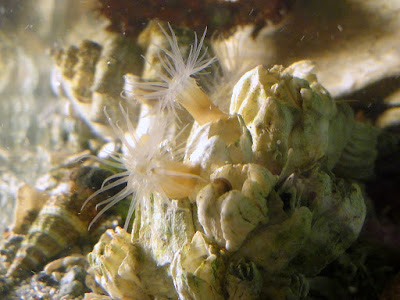For those that didn't see the original post, here's the story, in brief: air-borne pollution from a construction site next door covered the water, first in my outdoor seaweed bowl, and then in my marine invertebrates aquarium inside, under an open window. Most of the animals died that first week, leaving me with a few crabs and snails, two brain-damaged shrimp and a handful of sick hermits; these last all died by the second week.
The green shore crabs survived, but not without side effects; one big male lost both pincers, the day after he'd molted. The invasive mud snails were fine, as were the little predatory nassas and most of the barnacles. And my big wandering plumose anemone opened for business again.
 |
| Community pre-disaster. Small anemones, snails, barnacles and an amphipod. |
Since then, I've been silent, at least as far as aquarium blogging goes. I could have tossed the whole thing and started over, putting my few animals into a fresh tank, but I wanted to learn what goes into a recovery in the wild. And just as it is in the ocean, where oil spills take years to clean up, healing my small tank became a long, slow process, with tiny improvements and discouraging setbacks.
The first imperative was to clean the water. This is easier in a small aquarium than in the ocean, of course. A few water changes, each time replacing half the water and cleaning the filter, should have been enough. The tank looked clean, and the crabs and snails went about their business cheerfully. But any animal that came along for the ride in fresh seaweed died in the first few days. I scrubbed the walls of the tank and changed the water again, to no effect.
 |
| Female shore crab, pre-disaster. |
The maimed crab molted. With the fresh molt, he had regenerated his pincers; they were smaller, less powerful than the originals, but he looked good.
And the very next day, when I fed him, he showed up with no pincers and missing two legs. The smallest of the crabs molted, as well, and lost a pincer the next day. Something was wrong.
 |
| One of the last photos of my grainy hand hermit, before the tank was poisoned. |
This time, I emptied the tank, scrubbed the walls, and removed the deep sand from the bottom. Once it was out of the water, I could smell it; a rank, chemical smell. There were no small animals alive in it, as there normally are. I dumped the whole lot, and set up the tank with only a dusting of clean, broken shells underfoot.*
All but one of the tiny anemones were gone, but the big one was still there, although she** spent most of her days closed in and hunkered down into a flat plate on the glass. To clean the glass properly, I would have to convince her to move.
Some species of hermits encourage anemones to attach themselves to the hermit's shell, boosting the hermit's weaponry and camouflage. The hermit nudges at the base of the anemone until it detaches from its chosen site, then he holds her gently against his shell until she glues herself down there.
I imitated a hermit. I pushed softly at the base of the anemone with the back of a fingernail. After a while, she let go and drifted to the bottom. I collected her and put her in a plastic bowl to wait until the tank was fresh and clean. When all was ready, I leaned on her again, then moved her back into the tank, down on the bottom with the clean shells. She attached herself, and after a bit of sulking, opened up to feed again. At least something was working!
 |
| Small snail, today, eating algae off the glass. The pink circle is the mouth, with the scraping radula. |
So that was done. After a couple of weeks with no more deaths, I added a few handfuls of pebbles to the bottom, and began to bring in new snails and amphipods; the snails to keep the algae down, the amphipods to feed the anemone. Things looked good, and I brought home a bag of sand; the crabs and snails dug in happily within minutes. The amphipods started to breed.
 |
| Amphipods love these crevices in an old barnacle shell. |
But there are other pollutants. Our problems weren't over. The anemone's story continues tomorrow.
*It's a pity we can't do that in the ocean.
** These anemones start out as males, and become females later on. I assume this one is old enough to be a "she".

Great to hear about your aquarium again, I was wondering how things were going after the heartbreak in the summer.
ReplyDeleteThat is quite a story. I was working at NOAA shortly after the oil spill and had quite an insight into all that goes into trying to clean up after such a disaster. Although nature itself does a remarkable job of breaking down the foreign substances, the impacts likely be evident (and certainly studied) for dozens of years in the future. Good luck with your little home.
ReplyDelete